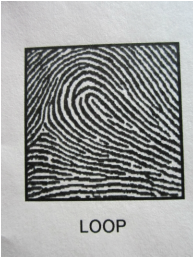Loops-
Loops can have two patterns.
A loop pattern can be an
ulnar loop or a radial loop. An
ulnar loop is a right hand slanted loop that flows in the direction of the
little finger. A radial loop is a
left hand slanted loop facing towards the radius bone in the thumb. The delta
is located on the left if a right hand ulna is present.
If the delta is located on the right side , an ulna is present. In order
for a pattern to be qualified as a loop, at least one (1) ridge must flow from
either side of the impression, and a delta and recurve must be present. A ridge
is a friction line on the finger print impression. A recurve is a ridge that
goes in and comes out the same side the ridge pattern entered. More than likely,
the recurve will be found next to or around the delta. A ridge connection or
attachment to the recurve will spoil it.
Type lines are located near the delta. These lines are two (2) ridges that
diverge, go parallel, or surround the pattern. When two parallel lines spread apart,
that is referred to as a divergence.
A delta is located at or near the point of divergence. A delta
characteristically looks like a triangle. If one (1) line divides or forks into
multiple lines, it is a bifurcation. To count the ridges in a loop pattern, one
must count the lines between the core and the delta.
The core is the inner most ridge. To do this, one must draw a line (real
or imaginary) and count each ridge the line crosses from the core to the
delta. The Henry Classification
code for loops are represented by R- radial or U-ulnar to describe the
loop. If a radial or ulnar loop is
present in fingers two (2) or seven (7) the processor will write a capital R or
U in the finger print block. All
other fingers receive a lower case r or u.
Loops can have two patterns.
A loop pattern can be an
ulnar loop or a radial loop. An
ulnar loop is a right hand slanted loop that flows in the direction of the
little finger. A radial loop is a
left hand slanted loop facing towards the radius bone in the thumb. The delta
is located on the left if a right hand ulna is present.
If the delta is located on the right side , an ulna is present. In order
for a pattern to be qualified as a loop, at least one (1) ridge must flow from
either side of the impression, and a delta and recurve must be present. A ridge
is a friction line on the finger print impression. A recurve is a ridge that
goes in and comes out the same side the ridge pattern entered. More than likely,
the recurve will be found next to or around the delta. A ridge connection or
attachment to the recurve will spoil it.
Type lines are located near the delta. These lines are two (2) ridges that
diverge, go parallel, or surround the pattern. When two parallel lines spread apart,
that is referred to as a divergence.
A delta is located at or near the point of divergence. A delta
characteristically looks like a triangle. If one (1) line divides or forks into
multiple lines, it is a bifurcation. To count the ridges in a loop pattern, one
must count the lines between the core and the delta.
The core is the inner most ridge. To do this, one must draw a line (real
or imaginary) and count each ridge the line crosses from the core to the
delta. The Henry Classification
code for loops are represented by R- radial or U-ulnar to describe the
loop. If a radial or ulnar loop is
present in fingers two (2) or seven (7) the processor will write a capital R or
U in the finger print block. All
other fingers receive a lower case r or u.

